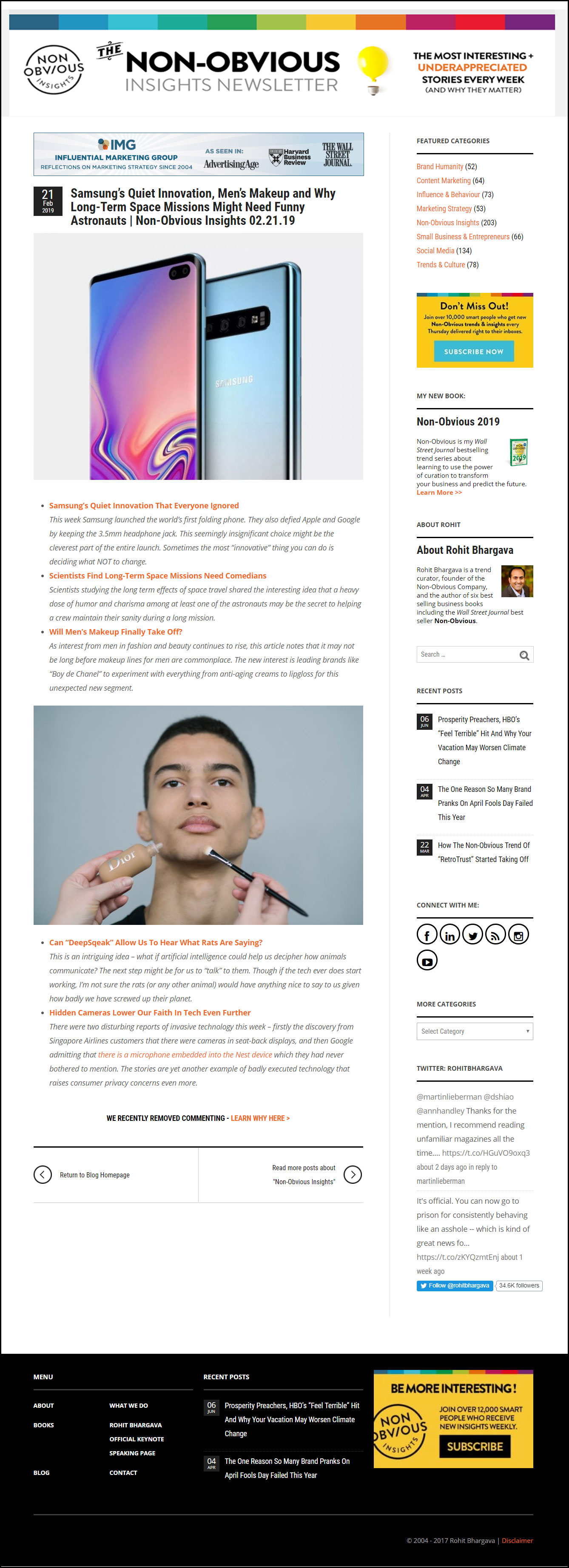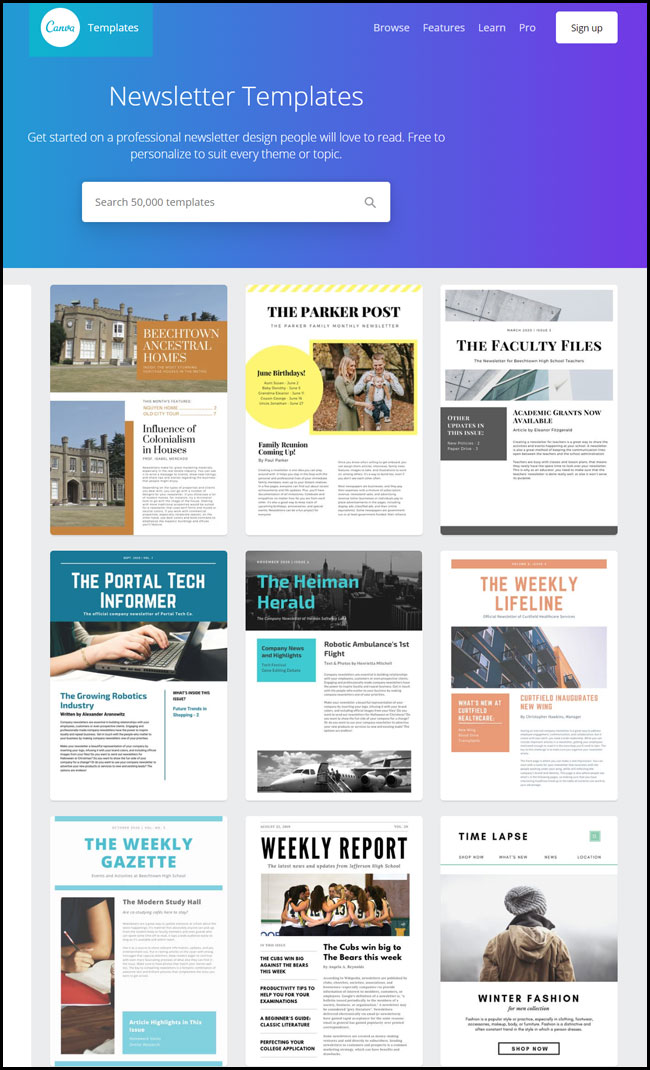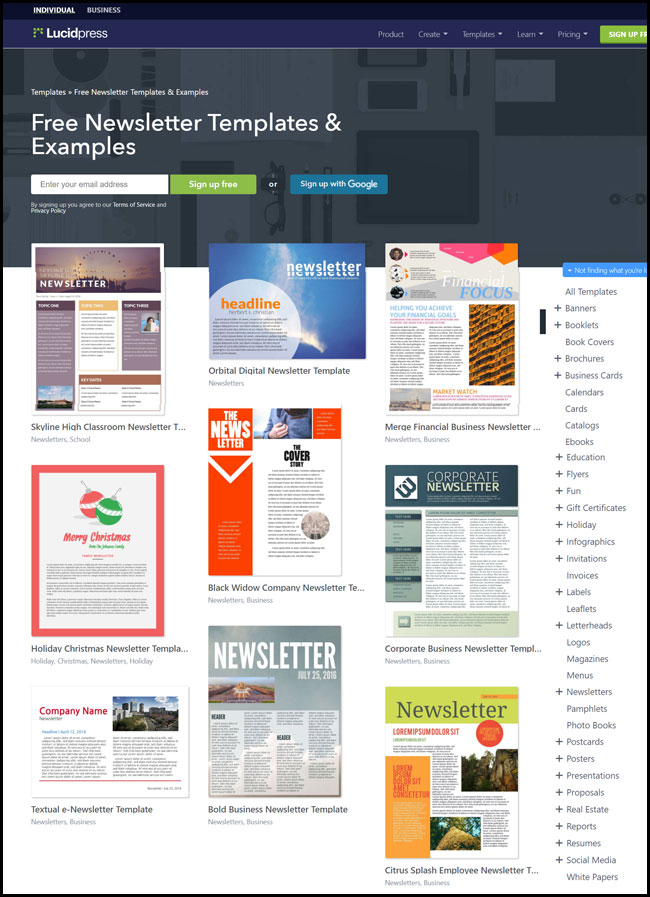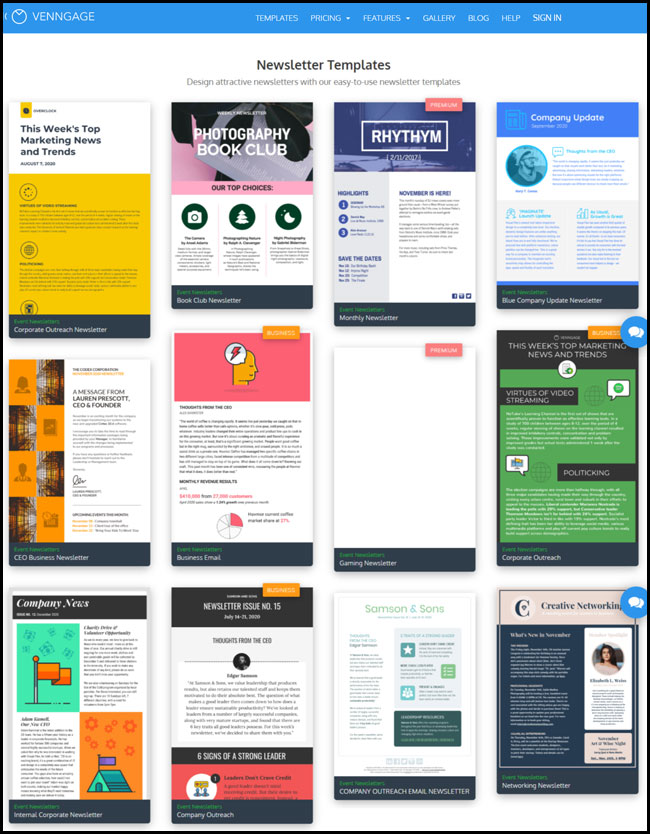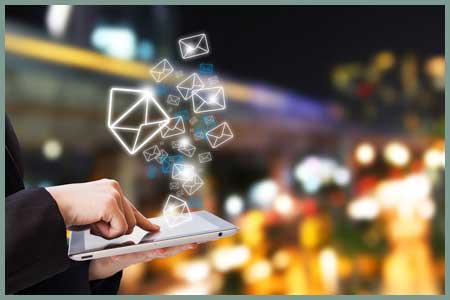
In Case You Didn’t Notice, The Good Ol’ Newsletters Are Back In Business Like Never Before, And How
We all are making the mistake of thinking newsletters are old hat in the online world. But what do you know, newsletters are making a huge comeback in the digital space.
As Contently writes: “Email may be old-school, but having the most relevant pieces of news handed over to you in a digital package is still extremely valuable.”
How are newsletters different from any other email marketing? The difference is this. Newsletters offer “roundups” that people find easier to catch up with. They arrive less frequently, but have a lot of topically-clustered information.
In a world of “emails-as-letters”, these are “emails-as-mini-magazines”. Instead of receiving endless small spammy emails, people seem to be returning to the preference for the more substantial newsletters.
At Solohacks Academy, we think Knowledge Commerce marketers who send out newsletters hold “convenience” and “attention focus” of the subscriber uppermost. Brands that consolidate and send relevant, valuable newsletters help subscribers. They reduce the email-receiving load for subscribers, while increasing the email-content value.
1. Why Do We Need To Care About Marketing Newsletters?
Newsletter marketing used to be a great tool once. That was when we all sent “broadcast” newsletters to everyone on our mailing list, and we didn’t bother to skew emails to different people differently, with a view to nudging them closer to buying whatever we were selling.
But then just when we all thought the newsletter’s days are over and it’s all about customized emails, the humble newsletter has had a resurgent appeal. Why? Read on …
a. Here’s Why Newsletters Deserve A Second Look From Knowledge Marketers
Morra Aarons-Mele writing in her article “The The Triumphant Return of the Email Newsletter” in the Harvard Business Review says: “Most of us don’t want more content – we want less, but better. That’s why newsletters like The Skimm have millions of subscribers – they’re easily digestible, usually providing four or five news items each morning, providing links where interested readers can take a deeper dive. And they’re regular, arriving always on a certain day, at a certain time.”
Newsletter marketing statistics are beginning to show a rosy side
- Active email accounts have hit 5.6 billion by 2019, and it’s an upward curve for the oncoming years, especially among younger folk.
- 73 percent of millennials prefer communications from businesses to come via email. Newsletters are by far their preferred way to receive updates from brands.
- 99% of consumers check their email every day. 59% of respondents say newsletter emails influence their purchase decisions.
- Newsletter readers spend 80% more time on the website that sends them these messages. 72% of people cited email as their preferred source for promotional content.
As marketers, here’s what can we get out of newsletter marketing efforts
Among the many advantages we get from sending newsletters are these:
- Increased conversion and ROI (Return On Investment).
- Greater trust built with our audiences.
- Better attention and focus of readers to our offers.
- Consolidated brand-driven information helps reinforce our brands better.
- We can have one more owned channel we can control.
What a newsletter can contain that an email can’t
People expect newsletters to be long and full of “roundup” information. A lot of advantages depend on what exactly we want to send as roundups in our newsletters. Some brands send curated “informational articles” as collections. Other brands may have “product roundups” as their newsletter themes. The smartness comes in knowing what your audience values – and to send them exactly that.
How a one-way newsletter can become a two-way interactive dialogue tool
One great newsletter I get from an SEO expert addresses questions people most ask about SEO. Each week the newsletter contains six questions around a common topic, with great answers. This is very refreshing as an idea, because it’s less about the brand. The whole newsletter is very audience-oriented.
This newsletter also encourages us subscribers to send in SEO questions we have. I have had many of my questions answered. It’s almost like having a “mastermind class” each week in my inbox. What started as an FAQ-style newsletter has now evolved into more of an interactive tool. Many of us “questioners” have bonded into a community, where we all now know each other well.
b. Five Features Every Newsletter Must Be Careful About
Varied businesses use newsletters in varied ways. Much depends on your reader research and your continuous improvement. Despite differences in strategy, all newsletters must be careful about five features. Here is a quick checklist …
Creative email subject headlines
These can help entice readers to open the newsletters. But the headlines must also accurately represent the contents of the newsletters.
In general, it helps to be neither too dull nor too hyped. Email subject lines that work well are those that are intriguing, and make people want to open them.
Avoid exclamation marks, and include emojis with care. Emojis do work well, and they can increase opens. But overusing them can make your newsletters look like spam.
Relevant, consistent scheduling
Information should be specific and relevant to target audiences. The frequency of the newsletters must also remain consistent and regular.
Maintaining your schedule creates a sense of brand professionalism. So does maintaining a steady tone of voice for your brand.
Take care to study which geographies your target audience lives in. Decide the best time of day to send your newsletters based on geographies. If needed, send each newsletter in batches, based on best times for people in different time zones.
Adding strong Calls-To-Action
Newsletters need not remain as mere information pieces. They can include strong calls-to-action. This may be any kind of next action you want readers to take. Making people take actions bonds them to your brand. In fact, experts say that every piece of content must have some Call-To-Action or it would not be marketing content, it would be just be journalism.
Your Call-To-Action can ask people to click links to read more information on your site. You can make them respond to exclusive “subscriber-only” product deals. Or you can get them to give you their answers to surveys.
People don’t act unless you ask them to. But don’t sound like pushy low-class advertising. Tell them what actions to take next, to get more of what they may find useful. Let Calls-To-Action be about something that offers greater value to your audiences.
Uncluttered presentation format
Emails in general allow limited design elements. This is because we have a plethora of email clients used by people to read their emails. Newsletter designs and formats have to look as good in Gmail, say, as they would in Outlook. They also have to be laptop, tablet and mobile friendly.
Experiment with how your newsletter template looks on different email clients. Also check on different devices. Then choose the best design template and be consistent to that template. Maintain a distinctive, recognizable brand look and feel.
One more thing to remember. People don’t react well to overwhelming newsletter designs and colors. So be interesting in design, but not over the top.
The unsubscribe link is mandatory
The unsubscribe process under GDPR rules now needs to be clear and simple. You have to include a visible unsubscribe link in each marketing newsletter.
Some brands have till now tried making the unsubscribe link very small in font size. They must have hoped that people will miss seeing it and thus not click it. But not only is this devious-looking, it’s also not compliant with the rules. Besides, someone who wants to unsubscribe will find the link and use it, regardless of font size.
Only the quality of your newsletter will help keep subscribers on your mailing list. The content you put in your newsletters must stay useful, relevant and valuable to readers. If it continues to deliver on expectations, or even exceeds them, people will hang in there.
c. Six Main Types Of Newsletters For Your Arsenal
Many brands have more than one type of newsletter. Even if these are different in content and layouts, they should all be coherent to your brand theme. Some of the more common types of newsletters each brand can have are these:
The Product Update Newsletter
These are great for reminding people about the existence of your key products. Use these newsletters to keep the product in memory. Send out the newsletter on anything new about the product. You may have some new testimonials … or some new uses for the product … or some new product variations … or some new accessories … or even some new pictures of product use sent in by users.
The Event Announcement Newsletter
Use these when you want to announce events … like webinars, mastermind classes or other high points in your calendar. These newsletters should have a buzz. The should be very focused around the specific event and give lots of event details. Don’t mix up event newsletters with other kinds of information. This is not the place for tag-alongs like blog updates or product news.
The Blog Updates Newsletter
This is a great way to round up all your blog posts of the week and present them as “what’s happening on your blog”. The idea here is to show small excerpts of your blog posts with their visual thumbnails. Then give links to the actual blog posts on your site to read more. One-time visitors to your site must feel like making more visits.
The News Announcement Newsletter
You won’t always have something to announce. Don’t force the issue and make every little happening on your site an announcement. Your newsletters will lose value. Save these kinds of newsletters for big or newsworthy goings-on. You can use announcements when you’re adding a new feature to your website … or when new people are joining your team or panel … or when you have big interviews coming up with influencers … and so on.
The Newsletter for Ecommerce
Treat this as your mini-store in a newsletter. Usually, marketers pick a theme for each issue and show products around that theme. Do make sure you have some exclusive deals for your subscribers. Not all deals need to be price discounts. There can be special products or accessories only for subscribers. Or you can include some service extras at no cost. If there’s nothing special for subscribers, what’s the point?
The Seasonal Wishes Newsletter
Don’t ever forget to send out very lovely and warm newsletters for Christmas, New Year … and other red-letter days. People always feel like you’ve remembered them, no matter how many other such emails they get. Again, don’t try to sell anything in this kind of newsletter. That would be crass and take all the genuine sentiments out of the gesture. Stay with greetings for the festive season.
2. Three Best Newsletters Examples That Subscribers Love To Get
To get an idea of how different newsletter from different brands are built, here are some great examples. Notice how they are so different in their branding and tone of voice and content.
Innovative collections of interesting content are what makes newsletters tick. This is what makes newsletters memorable and open-worthy.
a. The Newsletter from Yoast SEO: An example of up-to-the-minute analytical and practical content of immense value to millions of online marketers
This newsletter is extremely simple looking, with its masthead and layout. But because the content is usually very useful, readers love to preserve these. The content usually talks of the latest advances in SEO and Google’s algorthmic changes. The article excerpts are from their Yoast’s blog posts.
Since Yoast is always on-the-ball on SEO changes, I find this to be one newsletter I will always stay subscribed for. The value is in the currency and importance of the content.
b. The Non-Obvious Newsletter from Rohit Bhargava: a curated collection of some really rare chuckle-worthy content from all over the web
Rohit Bhargava evangelises content curation. But while most of us haven’t the knack of curating really interesting tidbits of content, Rohit has mastered the game. His newsletter (obviously called The Non-Obvious) comes with so much intriguing and chuckle-producing content that it’s hard to ever give it up.
God alone knows where he gets such content from, but someone like him makes our days! Not all the content is frivolous. It’s meaningful – but plain damn “non-obvious”.
c. Total Annarchy Newsletter from Ann Handley: A twice-a-month newsletter that has enough on it for two months
We all know Ann Handley is a great writer. But that she has so much stamina is something you’ll be in awe of – when you see her newsletter. I know it’s real long and choc-a-bloc with the best stuff.
I could have shown you a smaller image, but I wanted to give you glimpse of its real length! Can you ever unsubscribe from this?
3. Aids And Tools To Help You Produce Outstanding Newsletters
Since most of us may have lost touch with newsletter design and writing, I thought it would be great to include some tools and aids – and advice – that will give us some ways to ensure we use the strongest principles of design and writing of newsletters
Here are some infographics that explain all the fine points to take care of, some excellent sources for newsletter templates you can run with, and some key points to keep in mind on best practices.
a. Two Terrific Infographics On How To Write A Newsletter
I have two goodies for you in this section. There are two great infographics here.
One shows you the anatomy of a perfect newsletter. It’s from Hoot Design, who compiled everything they learned over years into one anatomy lesson. The second infographic here is from Brafton, who have done their own step-by-step on how best to write a terrific newsletter.
Almost everything one can say about the best practices n newsletter writing are here, so feel free to get inspired!
To see the infographics in larger sizes, just click on them, and then use the magnifying cursor.
Infographic courtesy: HootDesign
Infographic courtesy: Brafton
b. Three Top Online Sources For Newsletter Templates
I’ve tried many different templates for my newsletters. But in the final analysis, the simplest ones seem to be the best. Three of the best sources for newsletter templates are these:
Lucidpress: Newsletter Templates
Venngage: Newsletter Templates
c. Seven Best Practices To Follow In Creating Newsletters
1. First decide if you need a newsletter
Can you create regular relevant content to share with your audiences? Or, are you only following what others are doing? Know what you want to achieve. It will help you set goals, and later measure your performance.
2. Set expectations you can adhere to
Let subscribers know what they’re signing up for. Be clear up front about what they’ll be receiving from you. Tell them how often they will hear from you. After declaring what to expect, don’t abuse audience trust.
3. Keep your content balanced
Experts give us a good rule of thumb for newsletter content. It should be 90% educational and 10% promotional. Remember you may have audiences that are not always homogenous. So keep content balanced.
4. Make sure you are “on-brand”
Be consistent to your brand standard for design, voice, and tone. But also don’t be afraid to have fun, here and there. Being too staid in a newsletter is not needed. Let the newsletter be where your brand can show it’s lighter side, by being less formal than your website.
5. Plan for “mobile first”
Research suggests that 54% of email is now opened on mobile devices. And that number continues to grow. Don’t tweak laptop-fit newsletter formats for mobile readers. Use “mobile-native” templates. There is a bigger difference than you think.
6. Make your subscribers feel exclusive
The way to build your community is to make your subscribers feel like a special lot. Give them deals that are exclusive, or share information that is only available to them. Give them some perks that make them feel they’d miss out if they ever unsubscribed.
7. A/B test and keep refining features
A/B test every aspect of your newsletter … the subject lines, mastheads, content layouts, number of images and so on. Also measure the metrics of performance like open rates, clickthroughs, calls-to-action and conversions. Get closer and closer to perfection.
In Summary …
- In case you didn’t notice, the good ol’ newsletters are back in business like never before. They are making a huge comeback in the digital space.
- Newsletters offer “roundups” that people find easier to catch up with. They arrive less frequently, but have a lot of topically-clustered information.
- In a world of “emails-as-letters”, these are “emails-as-mini-magazines”. Instead of receiving endless small spammy emails, people seem to be returning to the preference for the more substantial newsletters.
- Knowledge Commerce marketers who send out newsletters hold “convenience” and “attention focus” of the subscriber uppermost. They reduce the email-receiving load for subscribers, while increasing the email-content value.
- 73 percent of millennials prefer communications from businesses to come via email. Newsletters are by far their preferred way to receive updates from brands.
- There are tons of tools and resources to help you produce newsletters that are smart and interesting and looked forward to. Use your own innovativeness to the max.

